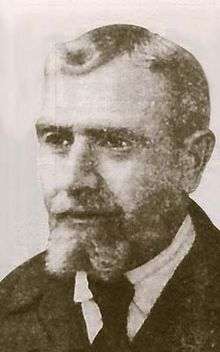Aleksandr Khanzhonkov
| Aleksandr Khanzhonkov | |
|---|---|
 | |
| Born |
Aleksandr Aleksejevich Khanzhonkov 8 August 1877 Khanzhonkovka, Don Host Oblast, Russian Empire |
| Died |
26 September 1945 (aged 68) Yalta, Crimean Oblast, Soviet Union |
| Occupation | Producer, film director |
| Years active | 1905–1926 |
Aleksandr Aleksejevich Khanzhonkov (Russian: Александр Алексеевич Ханжонков, IPA: [ɐlʲɪˈksandr ɐlʲɪˈksʲejɪvʲɪtɕ xənˈʐonkəf]; 8 August [O.S. 27 July] 1877 — 26 September 1945) was a pioneering Russian cinema entrepreneur, film director and screenwriter. He is known for producing Defence of Sevastopol, Russia's first feature film, as well as Ladislas Starevich's ground-breaking stop motion animation. Khanzhonkov had worked as a consultant in the post-revolutionary Goskino before been banned from cinema in 1926.[1]
Early Years
Khanzhonkov was born in the small village of Khanzhonkova of the Don Host Oblast (modern-day Makiivka, Donetsk Oblast) into a noble family of Don Cossacks. His father Alexei Petrovich Khanzhonkov was a landlord who went bankrupt. His mother Paraskeva Sergeevna Khanzhonkova (née Dmitrieva) came from a colonel's family who owned a Singer shop in Moscow. The noble title was first granted to Aleksandr's great-grandfather Vasily Khanzhonkov.[2][3][4]
Aleksandr studied in the Novocherkassk Cossack School and was sent to serve in the Moscow host after his graduation in 1986. He took part in the Russo-Japanese War which undermined his health.[2][4] In 1905, upon a discharge from military training due to health issues, Khanzhonkov sat in on a screening of Train Pulling into a Station by the Lumiere Brothers.[5] This marked the onset of his interest and subsequent investment in film, primarily as a producer but also as a director.
Career
In 1906 Khanzhonkov founded Russia's first cinema factory, A. Khanzhonkov and Co., whose main financial backer was Ivan Ozerov, an influential banker and member of the Russian State Council. Initial productions were shot on stage in the vein of Melies and were overshadowed by the work of Alexander Drankov. Known for his unabashed commercialism, Drankov would remain a competitor up to the revolution of 1917.[6][7]
It wasn't until 1911 that Khanzhonkov's factory would receive widespread acclaim with the release of Defence of Sevastopol. One of the earliest full length Russian feature films, it was equally notable for its technical aspects. By the end of 1912, Khanzhonkov had established a permanent studio in Moscow and went on to produce over a hundred films over the course of the next several years.[8][9] Much of Khanzhonkov's work during this time period went "virtually unseen by the Russian masses" and often took aim at aristocratic sensibilities or adapted great Russian novels of the 19th century.[10][11] Nonetheless, Khanzhonov helped create many standards in Russian cinema production; the first confirmed use of artificial light in the Russian film industry takes place in a Khanzhonkov documentary piece.[9]
During the Russian Revolution, Khanzhonkov fled Russia to Constantinople and Vienna, and, despite previous affiliation with the royal family, returned upon invitation to the USSR in 1923 and was appointed director of the new Soviet studio Proletkino and later as a production consultant for Goskino. His career in the Soviet Union ended in 1926: he was forced to abdicate after a corruption scandal struck Proletkino, and never worked in cinema again. Khanzhonkov spent the rest of his life in Yalta, living on a personal pension from the state. There he survived the Nazi occupation of Crimea in 1941–1944, and died in Yalta after many years of declining health on September 26, 1945.
Bibliography
- Ханжонков, А.А. 1937. Ранние годы русской анимации. Москва/Ленинград: Искусство.
- Кузнецова, М. 1997. Александр Ханжонков. Жизнь за кадром. Москва: "Профил" No. 29.
- Янгиров, Рашит. 2001. К биографии А.А. Ханжонкова: Новый ракурс. Москва: "Киноведческие записки" No. 55.
References
- ↑ Peter Rollberg (2016). Historical Dictionary of Russian and Soviet Cinema. — Rowman & Littlefield, p. 3 ISBN 978-1-4422-6842-5
- 1 2 Irina Orlova (2007). Dedicate My Life to Cinema. — Donetsk: Promin, 127 pages (Biography)
- ↑ Interview with Aleksandr Khanzhonkov's granddaughter Irina Orlova from the Evening Donetsk newspaper № 73, May 18, 2007 (in Russian)
- 1 2 Maxim Medvedev. A slave of cinema in the garden of the parting paths article at Chastny Korrespondent, August 8, 2014 (in Russian)
- ↑ Prominent Russians: Aleksansdr Khanzhonkov in Russiapedia
- ↑
- ↑ Leyda, Jay (January 1947). "Prologue to the Russian Film (Part Two)". Hollywood Quarterly. 2 (2): 171.
- ↑ F. Jahn, Hubertus (1944). "For Tsar and Fatherland? Russian Popular Culture and the First World War". Cultures in Flux. Princeton University Press. p. 141.
- 1 2 Cavendish, Philip (April 2004). "The Hand That Turns the Handle: Camera Operators and the Poetics of the Camera in Pre-Revolutionary Russian Film". The Slavonic and East European Review. 82 (2): 214.
- ↑ Gaines, Jane (Spring 1995). "Revolutionary Theory/Prerevolutionary Melodrama". Discourse. 17 (3): 103.
- ↑ Tsivian, Yuri (1991). Early Cinema in Russian and its Cultural Reception. p. 132.